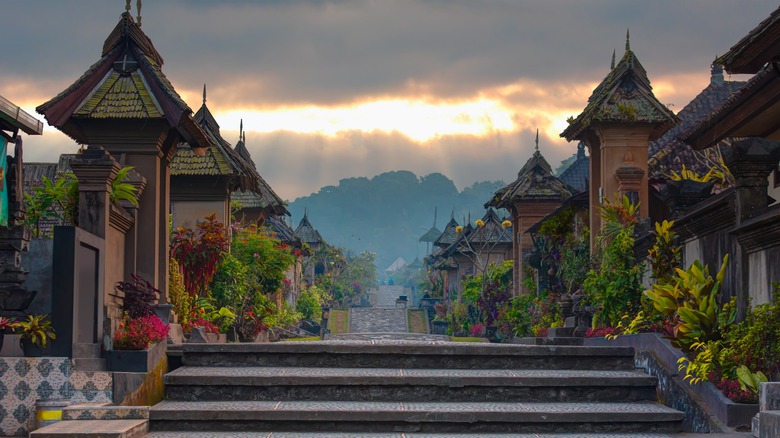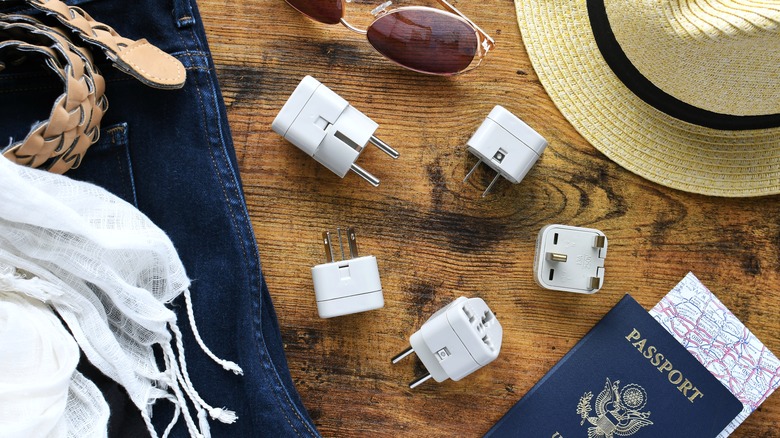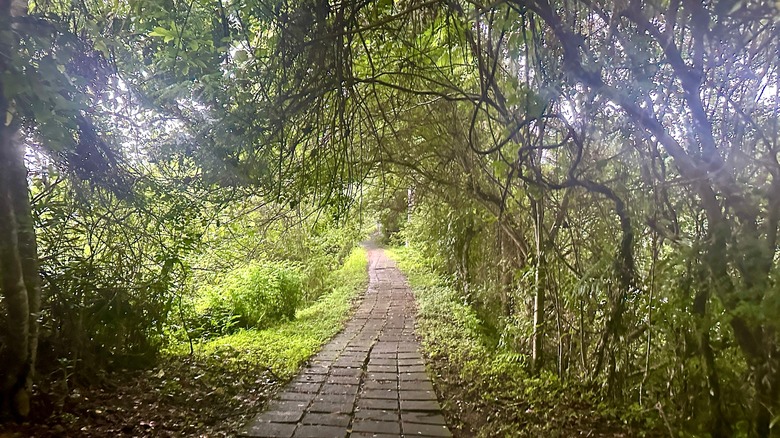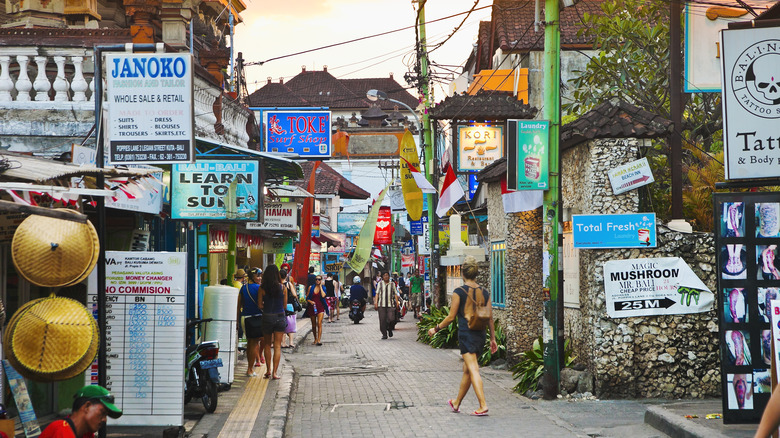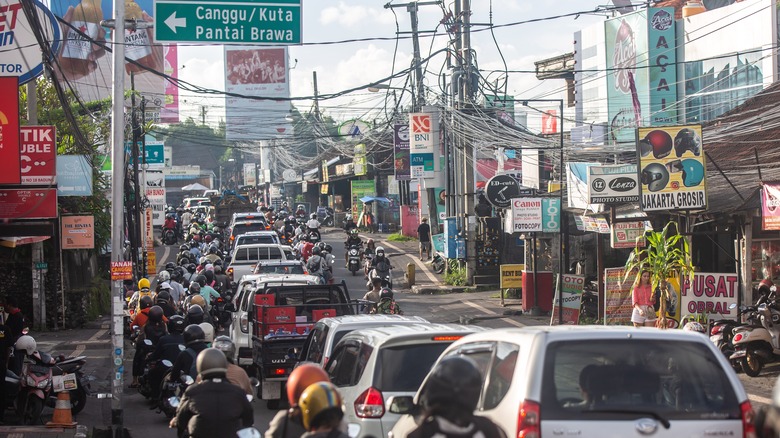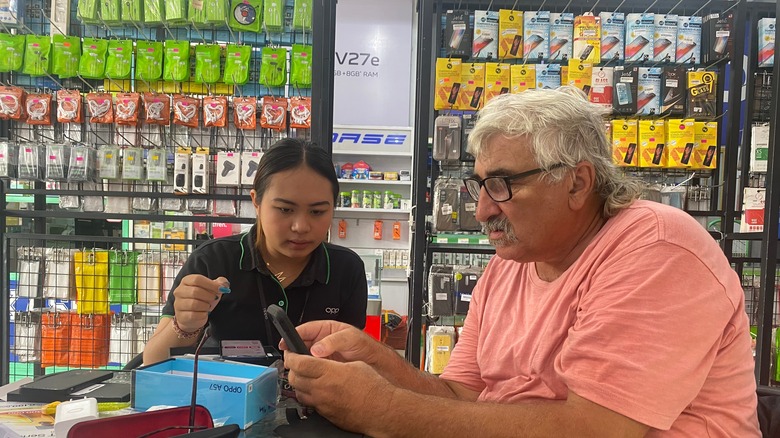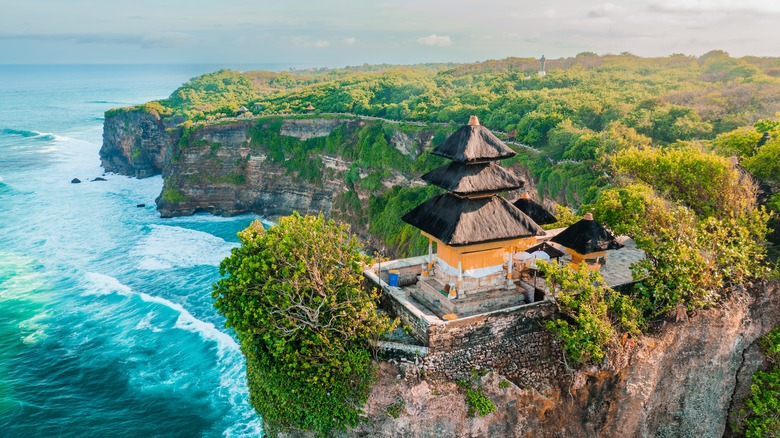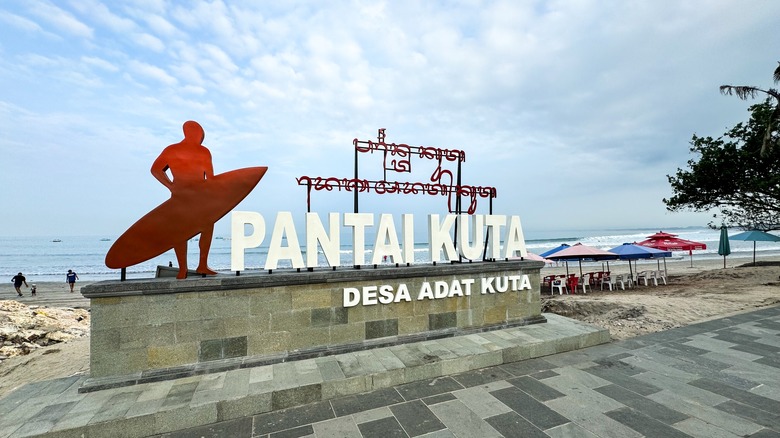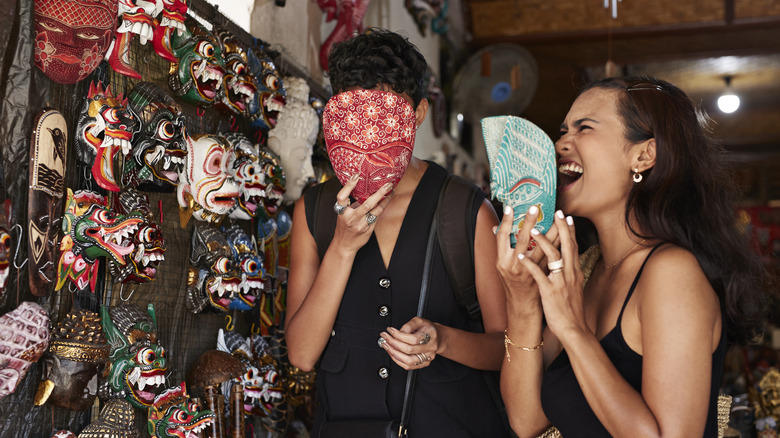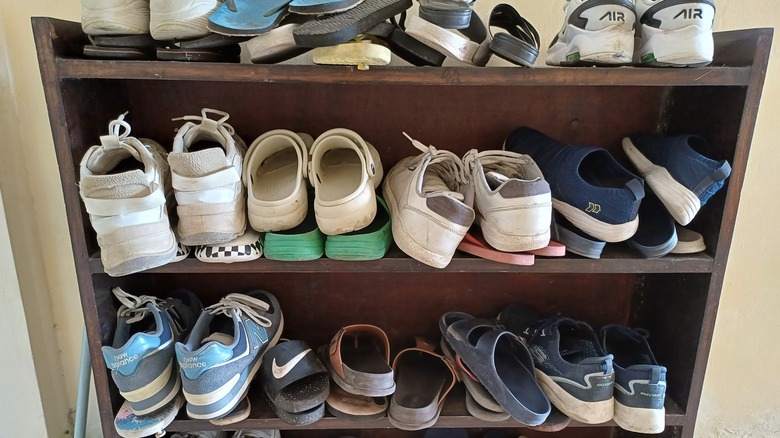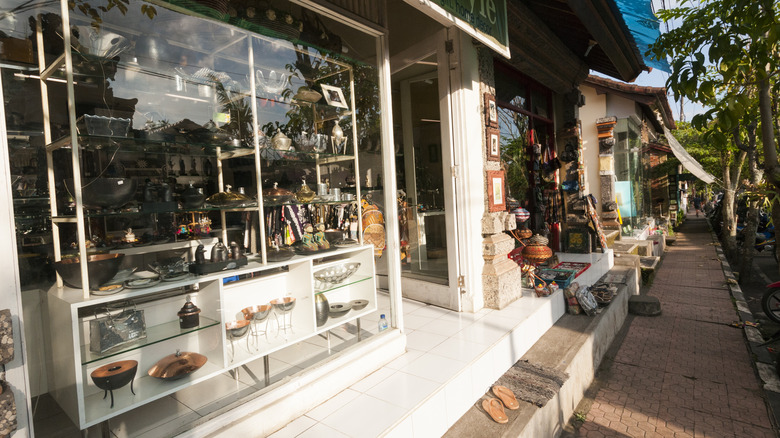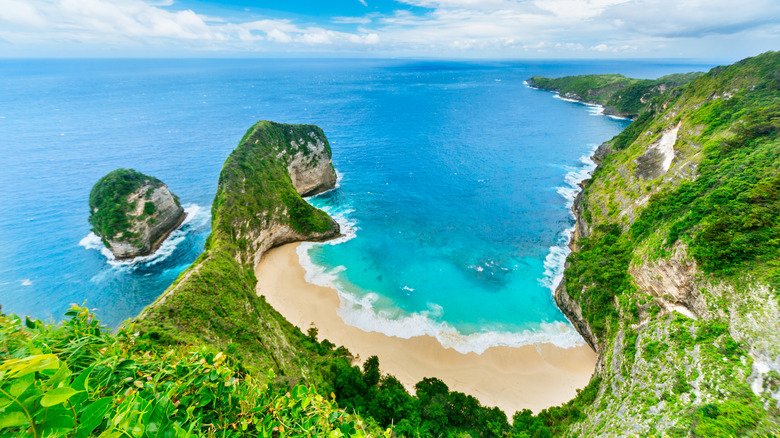17 Essential Travel Hacks For Your Tropical Vacation To Bali
We may receive a commission on purchases made from links.
The Southeast Asian nation of Indonesia is a dream come true for lovers of islands (we don't mean this site; we already know everyone loves us!). It's home to more than 17,000 of them, after all, spreading all the way from areas west of Singapore to other isles that are close to Australia. Among them is Raja Ampat, a little-known archipelago with surreal beauty, and Bali, an island predominantly Hindu that welcomes millions of visitors each month.
The island is well-accustomed to tourism — we know, we've visited it on multiple occasions — and offers travelers the chance to see ornate temples by the sea, striking countryside, fine beaches, and stay at great beach resorts. For some, it's paradise. While the locals are very much used to outsiders zipping along their streets on scooters, hanging out at cafes, restaurants, and bars, and catching the waves on a surfboard, there are some things that any traveler should be aware of before a trip to the island. Take note, and your next visit to the "Island of the Gods" should be all the more enjoyable.
Bring a travel adapter
U.S. electrical goods have two-pin plugs that slot into wall sockets (some also have three pins), and the same is true for Bali. The problem is that the two pins in Indonesia are a different shape from those in the U.S. — rounded instead of flat — so you will need to carry an adapter. Standard multi-country travel adapters are available in stores and, of course, online, and they are definitely a smart accessory to have if you travel regularly.
However, they are a little bulky and can take up valuable space if you want to pack just one carry-on for a week-long vacation. A direct adapter specifically for this type of outlet (Type C or F) is smaller and can be purchased in advance, or you can try to source one when you arrive. Also, note that Bali's electricity courses through its wires at 230 volts. For small electronics, like laptops, tablets, and phones, the adapter can handle this higher voltage (U.S. current is 110 volts), but for larger appliances, you will also need a converter.
Avoid the island from November through April
There's a good chance that you will spend a sizable chunk of your time in Bali outdoors. That could be for anything from flitting between small boutiques in the neighborhood Canggu, lounging on the long beach in Seminyak, visiting one of the island's many temples (though avoid the one that is a total tourist trap), or admiring the verdant, hilly countryside around Ubud. All of that is best done when the conditions are reliably sunny and dry, and for that, you should not book a trip between November and April.
This period is the rainy season in Bali, and while this doesn't mean it will rain all day or even every day, the rain is consistent enough to make being outside unpleasant. The most intense rain generally occurs in December and January. There is one benefit of visiting during the wet season, though — you will encounter fewer tourists and might be able to snag cheaper room rates. So, perhaps, if you are adventurous enough, don't snub this less-crowded season and book a trip to Bali.
Choose the appropriate location
At more than 2,200 square miles, Bali is larger than the state of Delaware. Given its dimensions, it shouldn't come as a surprise that different regions of the island have a wildly unique feel and ambience. Some parts are associated with mass tourism, but others are much more peaceful — generally, this equation correlates to distance from the airport.
If you want action, lots of shops, places to eat, and a range of offerings to keep you entertained, think about a destination nearer the airport in the island's south. These include Kuta and Legian; Seminyak and Jimbaran are popular with travelers but more upscale. More tranquil Ubud, in the center of the island, is home to many yoga retreats and surrounded by beautiful rice paddies that we've had the good fortune to see. If you really want to get away from the tourists, head to the north of the island, where the atmosphere is slower, more laid-back, and primed for relaxing.
Don't rent a car
Driving in Bali is no fun, and the traffic can be horrendous. Explaining the situation, an expat who has lived in Indonesia for a decade wrote on the subreddit r/bali, "I own a car I drive regularly, and I never driven a car in Bali and can't think of a circumstance that would push me to. Traffic conditions are already crazy where I live, but Bali is next level crazy [sic]." There are scooters and motorbikes everywhere, some roads are very narrow, and traffic jams are frequent, especially in the high tourist areas.
That said, many visitors rent a scooter, which can be a convenient way of shuttling around the island and is cheap, often costing less than $10 a day. But an easier option is to get cabs or rides on the back of a motorbike (sounds scarier than it is). For this, download the apps GoJek and Grab (the latter is like Uber), which are ride-sharing services that are based in Southeast Asia — GoJek is an Indonesian company, while Grab is headquartered in Singapore.
Get a local SIM
Roaming plans can be expensive, and with prices of $5 per day, for instance, not seeming like a lot, it adds up when you calculate the total for a two-week vacation. A much smarter option is to get a SIM card offered by an Indonesian carrier. They are ridiculously cheap and are available all over the place, even at the airport on arrival. A few carriers dominate the market, such as Indosat Ooredoo Hutchison, Telkomsel, and XL Axiata. Using any of them should suffice — just go for the one that offers the best deal at the time.
Getting a SIM is effortless. There are booths near the arrivals area at the airport (vendors often sell a tourist SIM, but this isn't always the best deal available), cellular stores around the island, local cellphone shops and booths, and even people on the streets hawking SIMs. Just be sure that the card connects to the provider before handing over your cash.
Eat local food
Since tourism is so prevalent in Bali, you'll find a Hard Rock Cafe, Pizza Hut, and the usual burgers-and-fries fast-food joints. In some of the more touristy areas, you'll discover places serving Italian, Japanese, and even South American food. But why would you eat these when the island has its own rich culinary traditions? Bali has a plethora of its own unique dishes, ones that you might not even find in other parts of Indonesia. Lawar, for example, combines meat, vegetables, and coconut in one hearty plate.
The salad urab bathes vegetables like cabbage and spinach in a dressing packed with ingredients, shallot, chili, coconut, and lime juice among them. And the most famous dish might be Babi guling, or suckling pig, where the meat is roasted with spices and comes out crispy, a pleasing contrast to the rice it usually accompanies. Warungs, or small locally run shops that prepare food, are great places to sample these local delights.
Embrace its nature
Get your camera ready because some parts of this island are spectacular. Once you've seen the terraced rice paddies around Ubud, for instance, you'll never forget them, and thanks to your phone, you'll never have to. Other pieces of the great outdoors are equally breathtaking. While it can be tempting to hang out in tourist areas and spend your trip going to breakfast, the beach for relaxation, a café for lunch, a nice restaurant for dinner, and then a bar or club to close the day, there's so much more to Bali that food and entertainment. Explore the varied geography of the island and take advantage of the setting.
You'll get to see the bright green paddies, for starters. There are also areas of mangrove forest, sections of mountains, dense, humid jungles, steep cliffs (some with a temple on top) that look over crashing waves, and lots of beaches. And within those rich environments, visitors will be able to spot a range of wildlife, especially birds.
Slather on sunblock generously
Bali isn't far south of the Equator, and one thing you can be guaranteed of is sunlight. Strong sun all year round, even in the wet season when the pulsing rays peek out from behind the clouds. Since you'll hopefully be spending good portions of your trip outside, enjoying the island's many exterior treasures, you'll be exposed to that sun frequently. It is at its most brutal from 10 a.m. to 4 p.m., so if you want to avoid the worst of it, minimize your exposure to it during those hours.
Whenever you are out, cover yourself in sunblock. Wear broad-brimmed hats, and definitely carry sunglasses with you everywhere. Getting sunburned is very painful and can have long-term consequences. Additionally, dehydration is a risk, so drink plenty of water throughout the day. Just be sure that it isn't straight from the faucet, as Balinese tap water isn't treated enough to be potable.
Learn some lingo
While the island is an old hand with tourists, and many locals can speak some English, it's handy to learn a few phrases of Bahasa (the national Indonesian language) and even Balinese. In some parts of the island, there are locals who don't speak a lick of English, so a few choice phrases will pay dividends. Locals will appreciate your effort if you try to communicate in their language; it shows respect for and acknowledgment of their culture.
In Balinese, we'd recommend learning at least one way of saying, "How are you?" (Ken-ken kabare?), to which the answer is "I am fine" (Tiyang becik-becik) and "thank you" (Suksma). Other phrases, such as greetings, ordering food, and counting, are useful, and you can easily find tutorials on them online. Note that in Indonesian languages, the letter "c" is pronounced as "ch," so "becik-becik" above would sound out as "bechik-bechik."
Prepare to bargain
In Bali, you'll come across some shops that are known as "fixed-price." The name says it all, namely that the price you see marked on an item is the amount you will pay. Elsewhere, you have the opportunity to bargain and haggle for an item and hopefully settle on a price that you are happy with. You might want to purchase some souvenirs on the trip, for instance, or buy some jewelry for yourself or a loved one. These transactions might take place in a market or a street stall, places to find a great deal, and where you should always bargain.
You can even haggle inside a bricks-and-mortar store. Bargaining is an ingrained part of the shopping landscape in Bali, and you can try your luck with anything, even a hotel room. But once you start, be reasonable in your demands and respect the seller. After all, the vendors have to make a living from what they sell to travelers like you.
Have cash ready
While U.S. dollars might be accepted in many places worldwide, especially in countries close to America, Indonesia isn't one of them. The local currency is known as the Indonesian rupiah, and the majority of payments are made with it. Credit and debit card payments are commonplace, but in certain instances, nothing beats cash. This is true for taxis you might hail in the street (GoJek and Grab can charge to a card you have on file, or you can opt to also pay in cash).
For entries to temples, if you need to pay for parking, or if you buy food at a street stall, then cash really is the only method to use. The easiest way to get it is via an ATM machine — there are some at the airport outside the arrival halls. Elsewhere, try to use machines that are inside banks, as some exterior ATM machines are compromised by criminals who use card skimmers.
Don't expose too much skin
In addition to the real chance of sun damage when you flash the flesh in Bali, dressing modestly is respectful of island norms. Bali is a conservative place — you won't see locals wearing shorts, for instance, even though it's hot and humid — and away from the beach, you should certainly cover up. We're not saying that you should be covered from head to toe, but dress sensibly when walking around town or when going to the shops, not in the way that you would if you were partying on the beach.
Loose, flowing cotton and linen clothing is a good choice, especially anything that covers the shoulders, upper arms, and most of the leg. It's essential to have clothing that lets your skin breathe because it's hot and humid in Bali, whatever the season, and you will definitely sweat more than you care to remember. The only time you should cover up a bit more comprehensively is when you visit a temple — sleeveless tops or anything where your shoulders and upper arms are uncovered might bar you from entry.
Prepare for mosquitoes
While mosquitoes are a nuisance in some parts of the United States at specific times, in Bali, they are a constant. And in addition to blessing our skins with itchy bites, they spread dengue and Zika. These are very real issues — in 2016, 20,000 people in Bali were hospitalized with dengue. The best solution is to avoid getting bitten at all. This means using bug spray when outdoors, especially during dawn and dusk, and when in heavily green areas.
When you are in your room or outdoors, burning coils can sometimes help to repel mosquitoes, but this can also cause respiratory issues. A less troublesome method is to use the small tablets that slot into contraptions that attach to the plug socket — they emit a scent that apparently keeps mosquitoes away. If you do get bitten, Bokashi oil is a local favorite to apply on bites to relieve the itchiness.
Wear shoes that are easy to remove
For small businesses, you may have to take off your shoes when you enter — examples can include a warung or a spa — so packing shoes that aren't a pain to remove will make life a lot easier. It will be pretty obvious when you do have to take them off because you'll see a pile of shoes outside the shop. For large supermarkets, grocery stores, souvenir shops, and places used by tourists, removing shoes will not be necessary.
The same is true for large hotels, where everyone will be walking around with shoes on. If you have the good fortune to be invited to the home of a Balinese person, then you will definitely be expected to unsheathe your feet before entering the home. Of course, shoes are a definite no when walking into and around a temple.
Don't assume the cute monkeys are docile
In the town of Ubud, the Sacred Monkey Forest Sanctuary is a huge draw for tourists. It offers visitors the chance to see monkeys in the wild, in their own habitat, with the knowledge that the monkeys are approachable and relatively unfazed by human interlopers. It's a large forest, many acres in size, and has more than 1,000 monkeys that call the place home. More than being just a reserve where the monkeys are protected, it also holds spiritual significance to the Balinese, with the forest and the mammals considered sacred and temples among the trees, hence the name of the destination.
Seeing the monkeys wandering between people, staring inquisitively at visitors, and seeming to almost interact with tourists, as we've witnessed, can be quite heartwarming. But all these monkeys are still wild animals, and if they want your food, they can become quite aggressive, as a post on Nerd Nomads demonstrates. In it, the author describes how monkeys attacked tourists, in some instances drawing blood.
Step carefully
Walking along sidewalks or crossing roads, we're generally used to flat, easy-to-maneuver surfaces that are reliably uniform. In Bali, though, that's not necessarily always the case. The sidewalks can be uneven and have slabs or pavers missing, making walking along them akin to navigating a minefield. Sometimes, prayer offerings might appear by the side of the road, near the gate to a temple, or outside somebody's home. Don't step on or over them, as that would be considered offensive.
Roads can be beset by potholes, and while cars might be able to rumble over them unaffected, you could easily twist an ankle by stepping into one. The bottom line is that you always need to be alert wherever you go, so don't amble down the street staring at your phone as you might do back home. And wear sturdy footwear, unless you're going to the beach, with a thick sole to protect you from unpredictable terrain.
Take a trip to the other islands
Bali is beautiful, but for the best beaches and a great excursion, take a day trip or overnight journey to one of the nearby islands, like Nusa Penida. That island is known for its sublime scenery, with high cliffs that plunge right down into the sea, long beaches with sugary sand, and seas that are clear, turquoise, and begging to be enjoyed by swimmers. Among the highlights is Kelingking Beach, where forested cliffs cup a crescent beach of white sand, and the sea rapidly transforms in color from light turquoise to dark blue.
The water is equally alluring for its marine life — Nusa Penida is a renowned spot for manta rays, and the sea off Crystal Bay is a fine snorkeling area. Other islands nearby that make for a good trip are Nusa Lembongan and Nusa Ceningan, and even Lombok, which is like Bali's uncrowded sister. So, even on your Bali vacation, expect to spend time beyond Bali.
